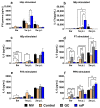Comparative Evaluation of Recombinant and Acellular Pertussis Vaccines in a Murine Model
- PMID: 38276680
- PMCID: PMC10818713
- DOI: 10.3390/vaccines12010108
Comparative Evaluation of Recombinant and Acellular Pertussis Vaccines in a Murine Model
Abstract
Since the 2000s, sporadic outbreaks of whooping cough have been reported in advanced countries, where the acellular pertussis vaccination rate is relatively high, and in developing countries. Small-scale whooping cough has also continued in many countries, due in part to the waning of immune protection after childhood vaccination, necessitating the development of an improved pertussis vaccine and vaccination program. Currently, two different production platforms are being actively pursued in Korea; one is based on the aP (acellular pertussis) vaccine purified from B. pertussis containing pertussis toxoid (PT), filamentous hemagglutin (FHA) and pertactin (PRN), and the other is based on the recombinant aP (raP), containing genetically detoxified pertussis toxin ADP-ribosyltransferase subunit 1 (PtxS1), FHA, and PRN domain, expressed and purified from recombinant E. coli. aP components were further combined with diphtheria and tetanus vaccine components as a prototype DTaP vaccine by GC Pharma (GC DTaP vaccine). We evaluated and compared the immunogenicity and the protective efficacy of aP and raP vaccines in an experimental murine challenge model: humoral immunity in serum, IgA secretion in nasal lavage, bacterial clearance after challenge, PTx (pertussis toxin) CHO cell neutralization titer, cytokine secretion in spleen single cell, and tissue resident memory CD4+ T cell (CD4+ TRM cell) in lung tissues. In humoral immunogenicity, GC DTaP vaccines showed high titers for PT and PRN and showed similar patterns in nasal lavage and IL-5 cytokine secretions. The GC DTaP vaccine and the control vaccine showed equivalent results in bacterial clearance after challenge, PTx CHO cell neutralization assay, and CD4+ TRM cell. In contrast, the recombinant raP vaccine exhibited strong antibody responses for FHA and PRN, albeit with low antibody level of PT and low titer in PTx CHO neutralization assay, as compared to control and GC DTaP vaccines. The raP vaccine provided a sterile lung bacterial clearance comparable to a commercial control vaccine after the experimental challenge in murine model. Moreover, raP exhibited a strong cytokine response and CD4+ TRM cell in lung tissue, comparable or superior to the experimental and commercial DTaP vaccinated groups. Contingent on improving the biophysical stability and humoral response to PT, the raP vaccine warrants further development as an effective alternative to aP vaccines for the control of a pertussis outbreak.
Keywords: DTaP vaccine; PTx neutralization; efficacy of acellular pertussis vaccine; mouse study; recombinant aP vaccine.
Conflict of interest statement
The authors declare no conflicts of interest.
Figures







References
Grants and funding
LinkOut - more resources
Full Text Sources
Molecular Biology Databases
Research Materials
Miscellaneous

